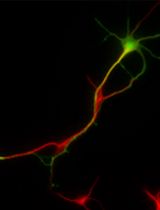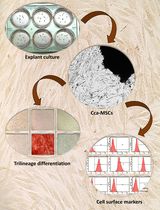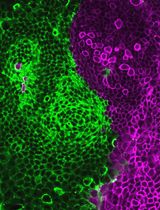- EN - English
- CN - 中文
Isolation of Murine Primary Aortic Smooth Muscle Cells
小鼠主动脉平滑肌细胞的分离
发布: 2021年02月05日第11卷第3期 DOI: 10.21769/BioProtoc.3907 浏览次数: 7921
评审: Pilar VillacampaSonal Arvind PatelAnonymous reviewer(s)
Abstract
Vascular smooth muscle cells (VSMCs) have been cultured for decades to study the role of these cells in cardiovascular disorders. The most common source of VSMCs is the rat aorta. Here we show the adaptation of this method to isolate and culture mouse aortic VSMCs. The advantage of this method is that there are many more transgenic mouse lines available compared to rats. The protocol consists of the isolation of the aorta, the liberation of vascular cells by the action of collagenase, culturing of VSCMs, and analyzing filamentous actin and alpha smooth muscle actin by fluorescence microscopy. VSCMs can be further used to study mechanisms underlying cardiovascular diseases.
Graphic abstract

Figure 1. Working steps
Background
Cells of the blood vessel wall (mural cells) are critically involved in the regulation of several disorders, from hypertension (Rodríguez-Vita et al., 2005a) and atherosclerosis (Rodríguez-Vita et al., 2008) to cancer (Wong et al., 2020) and more recently even COVID-19 (He et al., 2020). Whereas capillaries are mostly covered by pericytes, larger blood vessels contain VSCMs in the vessel wall. Mural cells control blood flow by vasoconstriction and vasodilation. As such, they are the target of several drugs which lower blood pressure (St. Paul et al., 2020). VSMCs stabilize blood vessels and are involved in restricting vessel permeability. Mural cells also limit angiogenesis and the presence of a tight VSMCs network is a feature of mature vessels (Hungerford and Little, 1999). VSMCs can also get activated and transdifferentiated into fibroblasts which contribute to tissue fibrosis (Rodríguez-Vita et al., 2005a and 2005b). In summary, the unique role of VSCMs in the maintenance of vascular homeostasis and control of blood flow makes cultured VSMCs a valuable tool in studying cellular and molecular mechanisms of vascular biology.
Here we describe a method to culture VSMCs from mouse aortas. This method is an adaptation from a method employed in rats 15 years ago (Rodríguez-Vita et al., 2005b). It allows evaluating the specific role of VSMCs in vitro in pathological processes observed in vivo. The advantage of primary culture allows to study genetic manipulation in these cells by using aortas derived from transgenic mice. The high viral or liposomal transduction efficiency of these cells also allows to study the role of other genes for which no transgenic mice are available. There are a number of molecular analysis that can be performed with cultured VSMCs such as gene expression analysis, drug screening, cell migration, proliferation, or survival assays. For example, we employed this method recently to analyze the role of HTRA1 in VSMC maturation (Klose et al., 2019).
Materials and Reagents
Pipette tips (10 μl, 200 μl, 1,000 μl) (Starlab, catalog numbers: S1111-3700 , S1111-0706 , S1111-6701 )
60 mm cell culture dish (Falcon, Corning, catalog number: 353 004 )
15 ml conical tube (Corning, catalog number: 352096 )
50 ml conical tube (Corning, catalog number: 352070 )
Greiner CELLSTAR® multiwell culture plates 24 wells (TC treated with lid) (Merck, catalog number: M8812 )
Thermo ScientificTM SuperFrost PlusTM Adhesion slides (Thermo Scientific Fisher, catalog number: 10149870 )
Cover slips, circular, 24 mm (Th.Geyer, catalog number: 7629906 )
Mouse
Ethanol 70% (VWR, catalog number: 20821.33 0)
FBS (Merck, Biochrom, catalog number: S 0615 )
DPBS, w/o calcium and magnesium (Thermo Fisher Scientific, catalog number: 14190169 )
DMEM, low glucose, GlutaMAX, pyruvate (Thermo Fisher Scientific, catalog number: 21885108 )
Collagenase, Typ II (Thermo Fisher Scientific, catalog number: 17101015 )
Fungizone-Amphoterecin B (Thermo Fisher Scientific, catalog number: 15290018 )
Penicillin-Streptomycin (Thermo Fisher Scientific, catalog number: 15140122 )
Tween® 20 for molecular biology (AppliChem, catalog number: A4974 )
Glycin ≥ 99%, Blotting Grade (Carl Roth, catalog number: 0079.3)
ROTI® Histofix 4% (Carl Roth, catalog number: P087.3 )
Triton® X-100 Molecular Biology grade (AppliChem, catalog number: A4975 )
Alexa FluorTM 488 Phalloidin (Thermo Fisher Scientific, catalog number: A12379 )
InvitrogenTM DAPI (4',6-Diamidino-2-Phenylindole, Dilactate) (Thermo Fisher Scientific, catalog number: D3571 )
Fluorescence Mounting Medium (Agilent, catalog number: S3023 )
Incubation-collagenase media (see Recipes)
Permeabilization buffer (see Recipes)
Blocking buffer (see Recipes)
Equipment
One Channel Pipette (Volume 1-10 μl) (Eppendorf, catalog number: 3124000024 )
One Channel Pipette Volume 10-100 μl) (Eppendorf, catalog number: 3124000075 )
One Channel Pipette (Volume 100-1,000 μl) (Eppendorf, catalog number: 3124000121 )
Hemacytometer; Neubauer counting chamber (BRAND, catalog number: 717805 )
PIPET-Boy acu2 (Integra Biosciences, catalog number: 155000 )
Forceps Shandon, 10 inches (Thermo Scientific Fisher, catalog number: 6306 )
Spring Scissors fine, small blade, straight, 8 cm (Fine Science Tools, catalog number: 15000-03 )
Single-Use Scalpel, no.20 (Paragon, neoLab, catalog number: 1-1565 )
Autoclave (VWR, Tuttnauer, catalog number: 481-0585 )
Balance (KERN & SOHN, catalog number: PBJ 4200-2M )
Centrifuge with swinging-bucket rotor and adaptors for 15 ml and 50 ml conical tubes (Eppendorf, model: 5810, catalog number: 5810000320 )
Humidified cell culture incubator set to 37 °C and 5% CO2 (Thermo Fisher Scientific, HeracellTM 150CU, catalog number: 50116047 )
Light microscope (Leica Microsystems, model: Leica DM IRB )
Safety cabinet (Thermo Fisher Scientific, model: Safe 2020, catalog number: 51026638 )
Water bath (GFL, catalog number: 1012 )
Zeiss Cell Observer Motorized Widefield Microscope (Zeiss)
Procedure
文章信息
版权信息
© 2021 The Authors; exclusive licensee Bio-protocol LLC.
如何引用
Hubert, M. O., Vita, J. R., Wiedmann, L. and Fischer, A. (2021). Isolation of Murine Primary Aortic Smooth Muscle Cells. Bio-protocol 11(3): e3907. DOI: 10.21769/BioProtoc.3907.
分类
癌症生物学 > 血管生成 > 细胞生物学试验
细胞生物学 > 细胞分离和培养 > 单层培养
您对这篇实验方法有问题吗?
在此处发布您的问题,我们将邀请本文作者来回答。同时,我们会将您的问题发布到Bio-protocol Exchange,以便寻求社区成员的帮助。
Share
Bluesky
X
Copy link



.jpg)











